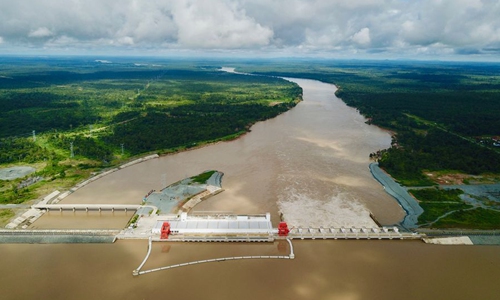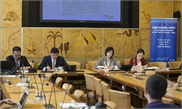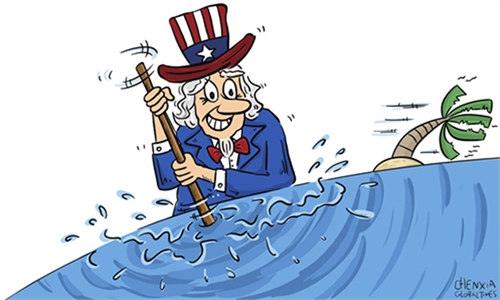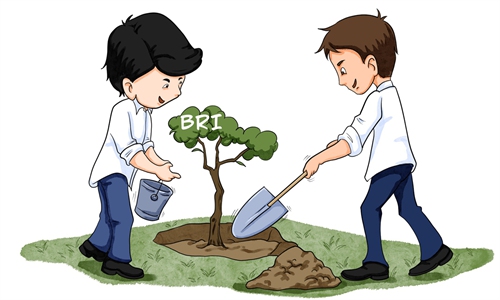HRW politicizes human rights with a biased report attacking Cambodian dam project

Aerial photo taken on Sept. 20, 2019 shows a view of the Lower Sesan II hydroelectric power station at Sesan District of Stung Treng Province, Cambodia. (Photo by Chen Gang/Xinhua)
Human rights are for humanity, not for Human Rights Watch (HRW). Human rights must be understood and approached based on the context and the stage of nation building and state building. Above all, human rights must not be politicized in the way HRW has done.To understand the nature of HRW, we need to understand its roots. Founded in 1978 during the Cold War, HRW was initially named Helsinki Watch to monitor the former Soviet Union's implementation of the 1975 Helsinki Accords and to examine and criticize "crimes" committed by the former Soviet Union and its allies, which has led to the long-standing Cold-War ideology carried out by the group under the disguise of a human rights organization. It is founded based on political ideology and propaganda. Clearly, HRW was a by-product of the Cold War whose raison d'etre would have ceased after the Cold War ended.
HRW has provoked politically and socially toxic environments through consistently fabricating misleading information and launching groundless attacks against Cambodia since the early 1990s. Truth be told, it fails to recognize the achievements made by the Royal Government of Cambodia in lifting millions of people from poverty. The rights to live and livelihoods are the most important human rights above all. We cannot talk about human rights if the people are hungry, and their livelihoods are under threat.
It is crystal clear that HRW's core members have had a long history of grudges against Cambodian leaders whom they have accused of violating human rights without presenting credible facts or evidence. Their ambition is to bring down the legitimate government by provoking people's discontent with and mistrust of the government.
On August 10, HRW released a 137-page report entitled "Underwater: Human Rights Impacts of a China Belt and Road Project in Cambodia" as part of its decade-long campaign to smear Cambodia's reputation and undermine the steadfast efforts by the Royal Government of Cambodia to steer the country toward peace, stability and prosperity.
The report claims that the construction of the Lower Sesan 2 dam has displaced about 5,000 indigenous people living near the site and that the dam has negatively affected the fishery ecosystem along the entire Mekong River basin.
With its long, troubling history of selective evidence gathering, lack of verifiable information, political bias and highly ideological analysis of human rights issues, HRW has unfortunately deviated from its stated objective of creating an "undeniable record of human rights abuses" and become nothing but an extension of the post-Cold War civilizing mission trying to sow public discontent and distrust in various parts of the world.
Judging based on its chronically questionable credibility, shady financial history, naked political bias and dubious research methodology, HRW's latest report on the Lower Sesan 2 dam should be dismissed for three reasons.
First, HRW claims that it interviewed 60 people in its preparation of the report, which constitutes only less than 1 percent of the 5,000-population sample it claims to have been affected by the dam. This sample size is too small and inadequate to be generalized in this kind of in-depth environmental study. Moreover, HRW failed to interview a vast majority of local people who have received fair compensation for their relocation and whose livelihoods have benefited from the construction of 12 schools, 12 kindergartens and numerous other public facilities created by the dam project.
Second, the report ignores the due process of the resettlement and compensation policy. The provincial committee developed guidelines for compensation to protect community assets-including community spiritual sites, local hard and soft infrastructures, private properties including resident land, houses and other sources of livelihoods, and allowance for target households.
Third, the livelihoods of the resettled population have relatively improved, contradictory to the totally dark picture painted by the report. For instance, the New Kbal Romeas village, one of three new resettlement villages, has better access to electricity and safe drinking water. These villages have started to plant cashew, sesame, corn, rice, cassava and other economic crops on their new lands.
The author is a Member of Parliament from Cambodia. opinion@globaltimes.com.cn



